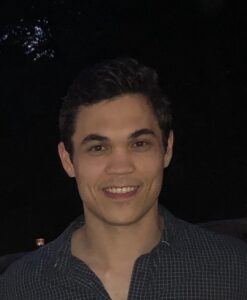Poetic Endings: Nailing Down the Threshold
Dia Calhoun and Deborah Bacharach
January 5, 2024
The End. Wouldn’t it be a relief if you could just end a poem like that? Every reader would know the poem had resoundingly concluded. You, as the writer, would know too. “The End” puts a final stamp of approval on a fairytale, but the story must still earn its ending by resolving a plot, finishing characters’ arcs, and getting our heroes back home. Just as there are structures in fiction that signal the story has concluded, there are also structures in poetry that accomplish the same goal. But here’s a big difference. While a powerful novel ending shuts a door by tying up loose ends, a powerful poem ending blasts a door open. It leaves the reader on the threshold feeling vivified by a confluence of energy and language that brought them to a new insight or understanding.
More on the Vivifying Threshold
Haven’t we all, in a bad mood, flung open the door and stood startled on the threshold, our mood instantly shifted by the sun-slapped view outside? We are vivified by the sudden change. As transitional spaces that separate two distinct places, a threshold can be external, as in the example above. It can also be internal as in a shift between one way of looking at or being in the world and another. Or it can be both. A threshold holds the tension of different states together. Because a threshold implies transition, it’s “both place and process” (Buck, 2004). A good poem ending, pushing images or ideas developed in the poem to a threshold, is the place where a new insight can arrive. The combination of place and process leaves the reader with a vivifying effect.
This vivifying effect, as defined by Marie Louise von Franz, noted Jungian analyst, is a useful way to understand the dynamics of a strong poem ending. “Every good [dream] interpretation should have a vivifying effect upon the conscious personality, a vitalizing effect” (2004, p. 89). However, as she notes below, this effect requires a certain effort or force:
There is a threshold difficulty . . .where it requires real effort to bring the two contents together. . .You have seen bubbles in your cup of coffee. There may be two which dance around each other and repel each other, and cannot combine; but then in a flash they rush and melt together and make one big bubble. To me this is an illustrative simile of what happens with unconscious and conscious contents. . . You need a certain force to bring them together. Suddenly you have the phenomenon of their coming together and of being enriched, of something having clicked
italics ours, von Franz, 2004, p. 89
A sudden force to bring things together sounds like a wonderful goal, but are there specific poetic techniques for achieving it? Yes. We will show how five different kinds of threshold moments listed below can create that powerful vivifying ending for a poem.
- Throw Down the Gauntlet
- Whirl Back
- Punch with Paradox
- Push Over the Edge
- Sweep Open the Curtain
A Note on Nails Before We Jump In
Have you ever been to a hardware store? The variety of nails is astounding. Long ones, drywall nails, finishing nails, roofing nails, 16 penny nails, etc. The final section lists the “nails” that hold down these vivifying thresholds. These craft tools signal This is the last line. The end is here. We have culled them for you from Poetic Closure: A Study of How Poems End by Barbara Herrnstein Smith and suggestions from Ellen Bass, Sarah Bitter, Stanley Kunitz, Joy Katz, and a few of our own. We love our thresholds and our tools. And we will show you how they both work in a strong poem ending.
Throw Down the Gauntlet
When the poem throws down a gauntlet, a speaker stands at a threshold and demands the reader take up a challenge—like Mary Oliver does in the end of her poem “The Summer Day”:
Tell me, what is it you plan to do
with your one wild and precious life?
In that last line question, a life-or-death challenge has been offered, and it thrills us. Throwing down the gauntlet demands action from the reader. We must answer a question, change our life, or just realize our life needs changing. Hoa Nguyen uses this technique brilliantly and subtly in her palindrome poem “Unrelated Future Tense”:
with me being a bastard
and Saigon tea will ask about my language
people will ask about bar girls
even without food in the poems
they will smell fish sauce and phở
ask about ‘the war’ which is to say
about men fathers and soldiers
about white Americans what
about them
about them
about white Americans what
about men fathers and soldiers
ask about ‘the war’ which is to say
they will smell fish sauce and phở
even without food in the poems
people will ask about bar girls
and Saigon tea will ask about my language
with me being a bastard
The speaker calls out assumptions the reader might have with her “being a bastard”: what food she eats, who her father is, how her parents met. The reader becomes the person being addressed who will demand deeply personal information that is none of their business, preparing the reader to recognize their culpability when the last line, “with me being a bastard,” throws down the gauntlet. But in the first line, “bastard” means being born out of wedlock and perhaps a person with a resilient, pugnacious attitude. In the last line it means every cruel, dismissive ugly thing you mean when you call someone “a bastard.” You, the reader, are the type of person willing to say this. And there we have the implied gauntlet: Now that you know this about yourself, what are you going to do about it?
Turning to our list at the end, the most obvious technique Hoa uses to nail this threshold down is the form. The palindrome, like all forms, carries the weight of ending with it. The poem is done because the form is done. The last line is also an unqualified assertion, another craft tool. Nguyen doesn’t write “maybe a bastard,” or “possibly,” “probably,” but writes with absolute certainly “with me being a bastard.” This, as Herrnstein Smith reminds us, helps us feel we are at an end. And finally, the music: tight assonance “with me being”, tight alliteration “being a bastard”, and regular rhythm “with me being a bastard” all make the words part of a cohesive end.
Whirl Back
At a “Whirl Back” threshold, the last line of the poem makes the reader say “Aha!” and completely reevaluate. Picture the reader getting to the threshold and the force of the ending turning her around as she shines a powerful flashlight on what has come before. Suddenly the reader sees all the previous lines in a new light. Ross Gay uses this type of ending in “Catalogue of Unabashed Gratitude.” The poem spills forth like a fast-moving stream rushing between its banks, barely staying between the banks. It’s full of “ruddy bombast” the bellow of “tubas and sousaphones, / the whole rusty brass band of gratitude.” It feels like it can and should never end, as the speaker says:
I can’t stop my gratitude, which includes, dear reader,
you, for staying here with me,
for moving your lips just so as I speak.
Here is a cup of tea. I have spooned honey into it.
If the poem had ended there, we would have been pretty satisfied, content to have been passed this sweetness, but perhaps not vivified. Gay’s actual ending does not restate that there can never be enough gratitude; he’s shown that vividly in the poem. Instead, he steps over the threshold and asks us to see everything that has come before in a new light. He turns back to the reader:
what do you think
this singing and shuddering is,
what this screaming and reaching and dancing
and crying is, other than loving
what every second goes away?
Goodbye, I mean to say.
And thank you. Every day.
Ah, we say. Ah, we are grateful for the transient; we love in spite of death. We are vivified by this insight, and now we can’t wait to return through the poem and cherish all the ants and walnut trees.
Gay uses several of the poetic closure techniques listed below. He switches from long sentences full of clauses that, by their very nature delay closure, to short sentences, to fragments. So, the pace gets slower and slower, drawing us to a halt. The final couplet is rhymed iambic trimeter. The sounds and rhythm tell the reader this moment is over. Gay also literally says “good-bye.” The final thought is one more turn, a direct address to the reader, thanking the reader and, given what he has just told us, obliquely reminding us that we too are worthy of love and about to die.
Punch with Paradox
Like Gay, Stanley Kunitz in “King of the River” also uses a rush of images and ideas to drive the reader to the end of the poem. With all the force of a salmon driving upriver, the end brings the reader to a threshold, but in this case, instead of looking back with new insight, we stay at this threshold. We feel in our guts and believe in our heads that two contradictory ideas are both true:
On the threshold
of the last mystery,
at the brute absolute hour,
you have looked into the eyes
of your creature self,
which are glazed with madness,
and you say
he is not broken but endures,
limber and firm
in the state of his shining,
forever inheriting his salt kingdom,
from which he is banished
forever.
“Forever inheriting his salt kingdom” is a logical contradiction to being “banished forever.” This clash of dynamic tension vivifies us, startling us out of our usual categories of distinction into the shock of both/and. The force of the poem prepares and pushes the reader to a place beyond logic. Yes, here, at this moment of vision, on this threshold, we resonate with the paradox.
Kunitz sets up the ending paradox by providing a penultimate moment, another craft tool, which is also a paradox. Six lines from the end comes the line, “He is not broken but endures.” That line is also an unqualified assertion, one of the nails that can hold down a threshold. Kunitz uses several Herrnstein Smith ending craft moves. “Banished” is an exit word. Consider how the repetition of the word “forever” does triple duty. “Forever” is a universal word, an unqualified assertion, and is repeated, acting like trumpets framing the threshold moment: “Forever inheriting his salt kingdom, / from which he is banished/forever.”
Pushed Over the Threshold
While Gay asks the reader to turn at the threshold and look backward with new eyes, in an opposite move a poet can push the reader over the threshold into a shocking revelation. This happens in Gerald Stern’s “The Dancing.” The arc of the poem takes us from the everyday, mundane world of broken furniture and wrinkled ties to a wild Dionysian frenzy of joy at the end. That contrast is part of the vivifying effect. The life-force of a dance carries us through the narrative toward the threshold at the end, where the shocking revelation is that this wild joy is about the end of WW2:
the three of us whirling and singing, the three of us
screaming and falling, as if we were dying,
as if we could never stop—in 1945—
in Pittsburgh, beautiful filthy Pittsburgh, home
of the evil Mellons, 5,000 miles away
from the other dancing—in Poland and Germany—
oh God of mercy, oh wild God.
The last line also sweeps us beyond the ending of the poem into the transcendent world, as though we are pushed over the threshold. This driving intensity of emotion vivifies the reader. In a similar vein to the Kunitz’ poem, the last line of “The Dancing” presents a paradox.
God is both merciful and wild.
“The Dancing” is a textbook study in nailing your ending. The penultimate “The dance / of old Ukraine” comes early and sets up the reader for Poland and Germany coming at the end. Without that set up, the reader would not entirely understand the wild dance of joy at the liberation of Poland and Germany. Other ending techniques are the repetition of the word “God,” and the repetition of prepositional phrases, “in 1945– / in Pittsburgh…. / in Poland and Germany.” The line, “screaming and falling, as if we were dying,” uses a word, dying, that we associate with endings. It also uses the terminal word “falling.” The phrases, “Oh God of mercy, oh wild God” are unqualified assertions. Except for “mercy” the words are all monosyllabic. The last three words of the poem all stressed, “oh wild God” absolutely serves as an ending, a stopping halt to the poem. The very structure of the poem, one stanza with one long sentence, the only period at the end, drives toward the ending.
Curtain Sweeps Open
When the curtain sweeps open, we experience not so much an Aha! but more of an Ahhh! That’s how these endings vivify us, as though we are standing on this threshold looking in awe at a new vista that rolls on and on without end. In January O’Neil’s “Mississippi Season,” the speaker thought she would never find physical affection again. She says:
For years I told myself
a story I could live with,
thought of myself
a kind of carnival fish
in a plastic bag
floating in my own still water,
waiting to be loved.
The poem ends:
And my mind, done
with all its stories,
turns to the carnal
as I rim the hinge
of his lips with my tongue
and dive into
this quenching.
Look at that final image. With this man, finally, the barriers have been swept aside, and the speaker dives in. To make this poetic end, O’Neil uses a verb with a terminal motion: quenching. Herrnstein Smith says, “There is a kinesthetic aspect to our responses, as if we’re subliminally, but nevertheless physically, participating in the motion so described. . .We feel in our bodies things are coming to an end” (Hernstein Smith, 1968). In this poem, however, we might feel that the poem has come to its end, but the quenching will go on and on.
Conclusion
The best poem endings open up the poem. When drafting your ending, try to imagine the particular type of threshold beckoning at the end of your poem. If your current ending is dangling off, read the whole poem aloud. When you reach whatever ending you have, picture the threshold. Does it leave you trembling in awe before a strange mountain? Are you gripping both sides of the doorframe trying to hang on? Or do you want to let yourself be blown across into a new country?
Gregory Orr writes in his section on thresholds in A Primer for Poets and Readers of Poetry, “The reader, in order to be moved by the poem must also experience the thrill and risk of the threshold” (2018, p. 57). What kind of experience is your threshold? It can help to imagine your physical self at that threshold. Is cold air blasting through hot air? Do you hear loud music? Or a whisper? What’s the mood? If you don’t have a clear vision, try writing five different endings, one for each vivifying technique. We found this method not only helped us find more powerful endings but helped us see new directions for the poem as a whole.
When you have a clear vision, consider the poem ending craft moves/techniques discussed next to build the reader’s experience of that threshold. We would never presume the five vivifying endings here are the only ones. When you read great poems that leave you vivified, identify what kind of threshold the poem uses. Then, using our discoveries or your own, get out your toolbox, get out your nails, and start building a powerful ending for your own poem that won’t be The End, but The Beginning.
Nails: Craft Tools for Nailing Down Your Threshold
To delve into the theory and practice of endings, we recommend Poetic Closure: A Study of How Poems End by Barbara Herrnstein Smith. Woven throughout this rather dense treatise are many craft tools you can use to signal This is the last line. The end is here. We have culled them for you along with suggestions from Ellen Bass, Sarah Bitter, Paul Valery, Stanley Kunitz, Joy Katz, and a few of our own. We love our thresholds. These tools help nail them down.
- Create a poetic structure with an end point. A sonnet or other closed form is the obvious one, but you can build your own in free verse. (Herrnstein Smith)
- Name the events people associate with ending: sleep, death, winter, homecoming. (Herrnstein Smith)
- Use verbs with a terminal motion: falling, sinking, disappearing. Smith says, “There is a kinesthetic aspect to our responses, as if were subliminally, but nevertheless physically, participating in the motion so described. . .We feel in our bodies things are coming to an end.” (Herrnstein Smith, 178).
- Use words that mean stop: stop, over, shut, close, end, good-bye. (Bacharach & Calhoun)
- End with a literal exit: a speaker walks away, drives away, walks out a door. (Bitter)
- Use correlative conjunctions that have an implied ending embedded in them: not only/but also, either/or, neither/nor. (Herrnstein Smith)
- Switch tense. We usually see past to present but sometimes present to future, past to conditional, etc. (Bitter)
- Shift the syntax, e.g. from hypotaxis to parataxis or vice versa. (Bitter)
- Repeat a word or phrase, although Katz reminds us that this can be overdone. (Herrnstein Smith, Katz)
- Use universals: all, every, none. (Herrnstein Smith)
- Use unqualified assertions: “He tells the truth” not “I assure you he tells the truth.” Don’t use qualifiers: some, more, less, sometimes. (Herrnstein Smith)
- Use superlatives: best, worst. (Herrnstein Smith)
- Use a regular rhythm and mono-syllabics. Smith says this “produces a strong, slow, and steady beat that hammers out each word distinctly and emphatically” (Hernstein Smith, 1968, p. 159).
- Use a penultimate line to set up the imagery for the last line. For example, if you have a cake in the penultimate line, you’ve prepared the reader for birthday candles in the last line. The closure is not as pleasant or clear if the two images don’t connect. (Bass)
- Use a central image subtly through-out the poem that will come out strongly in the last line. For instance, Ted Kooser’s poem “The Last Tomato” has “one last live coal in the ashes,” “other fires,” “curly smoke,” that sets up the last line “burning, burning.” (Bacharach & Calhoun)
- In an early draft if you have two consecutive stanzas on one subject, especially if the second stanza comes to a natural ending point—sleep, wake, arrive, leave. . . then separate those stanzas and move one to the end. That way the reader has the experience of seeing everything in the middle as integral to the ending image. (Bacharach & Calhoun)
- And we’ll end with Kunitz’s famous dictum: “End with an image and don’t explain.” (Kunitz)
References
Buck, Stephanie. (2004). Home, Hearth, and Grave: The Archetypal Symbol of Threshold on the Road to Self [Paper]. The Jungian Society for Scholarly Studies Conference, Salve Regina College, Newport, RI. https://sites.google.com/site/jungian3s/conferences/2004-conference-details-providence-ri/selected-papers-from-2004-conference
Gay, Ross. (2015). Catalog of unabashed gratitude. University of Pittsburgh Press.
Katz, Joy. (2011). Goodbye, goodbye, goodbye: Notes on the ends of poems. In M. Biddinger (Ed.) Monkey and the wrench: Essays into contemporary poetics. University of Akron Press.
Kunitz, Stanley. (1971). The testing tree. Little Brown.
Herrnstein Smith, Barbara (1968). Poetic closure a study of how poems end. The University of Chicago Press.
Nguyen, Hao. (2020). “Unrelated Future Tense,” Poetry northwest. https://www.poetrynw.org/hoa-nguyen-two-poems/
Oliver, Mary. (1990). House of light. Beacon Press.
Orr, Gregory. (2018). A primer for poets and readers of poetry. W.W. Norton and Co.
Stern, Gerald. (1982). Paradise poems. University of Pittsburgh Press.
O’Neil, January. (2021). “Mississippi Season,” Poetry northwest. https://www.poetrynw.org/january-gill-oneil-mississippi-season/
von Franz, Marie Louise (2001). Creation myths. Shambala.






